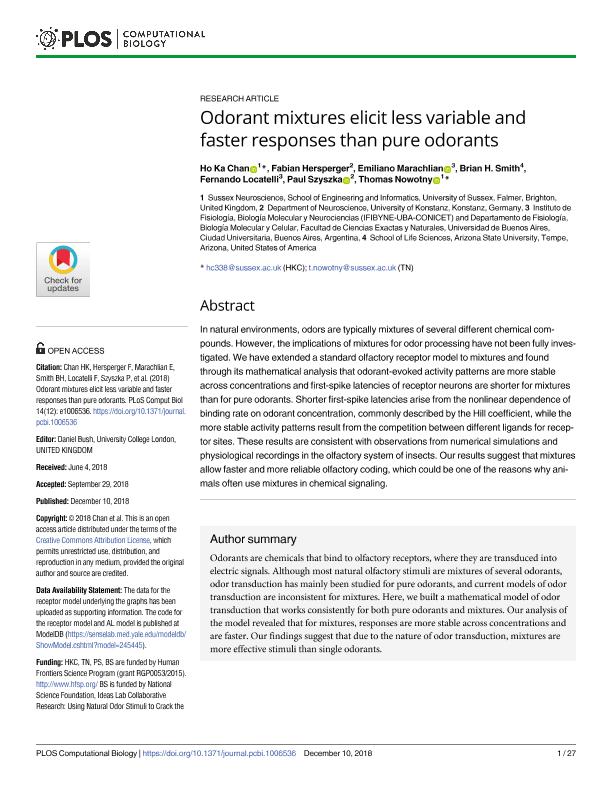Mostrar el registro sencillo del ítem
dc.contributor.author
Chan, Ho Ka
dc.contributor.author
Hersperger, Fabian
dc.contributor.author
Marachlian, Emiliano

dc.contributor.author
Smith, Brian H.
dc.contributor.author
Locatelli, Fernando Federico

dc.contributor.author
Szyszka, Paul
dc.contributor.author
Nowotny, Thomas
dc.date.available
2019-11-11T18:15:33Z
dc.date.issued
2018-12
dc.identifier.citation
Chan, Ho Ka; Hersperger, Fabian; Marachlian, Emiliano; Smith, Brian H.; Locatelli, Fernando Federico; et al.; Odorant mixtures elicit less variable and faster responses than pure odorants; Public Library of Science; Plos Computational Biology; 14; 12; 12-2018; 1-27
dc.identifier.issn
1553-734X
dc.identifier.uri
http://hdl.handle.net/11336/88497
dc.description.abstract
In natural environments, odors are typically mixtures of several different chemical compounds. However, the implications of mixtures for odor processing have not been fully investigated. We have extended a standard olfactory receptor model to mixtures and found through its mathematical analysis that odorant-evoked activity patterns are more stable across concentrations and first-spike latencies of receptor neurons are shorter for mixtures than for pure odorants. Shorter first-spike latencies arise from the nonlinear dependence of binding rate on odorant concentration, commonly described by the Hill coefficient, while the more stable activity patterns result from the competition between different ligands for receptor sites. These results are consistent with observations from numerical simulations and physiological recordings in the olfactory system of insects. Our results suggest that mixtures allow faster and more reliable olfactory coding, which could be one of the reasons why animals often use mixtures in chemical signaling.
dc.format
application/pdf
dc.language.iso
eng
dc.publisher
Public Library of Science

dc.rights
info:eu-repo/semantics/openAccess
dc.rights.uri
https://creativecommons.org/licenses/by/2.5/ar/
dc.subject
Olfaction
dc.subject
Coding
dc.subject
Comptation
dc.subject
Modelling
dc.subject.classification
Otras Ciencias Biológicas

dc.subject.classification
Ciencias Biológicas

dc.subject.classification
CIENCIAS NATURALES Y EXACTAS

dc.title
Odorant mixtures elicit less variable and faster responses than pure odorants
dc.type
info:eu-repo/semantics/article
dc.type
info:ar-repo/semantics/artículo
dc.type
info:eu-repo/semantics/publishedVersion
dc.date.updated
2019-10-21T19:13:54Z
dc.journal.volume
14
dc.journal.number
12
dc.journal.pagination
1-27
dc.journal.pais
Estados Unidos

dc.journal.ciudad
San Francisco
dc.description.fil
Fil: Chan, Ho Ka. University of Sussex; Reino Unido
dc.description.fil
Fil: Hersperger, Fabian. Universitat Konstanz; Alemania
dc.description.fil
Fil: Marachlian, Emiliano. Consejo Nacional de Investigaciones Científicas y Técnicas. Oficina de Coordinación Administrativa Ciudad Universitaria. Instituto de Fisiología, Biología Molecular y Neurociencias. Universidad de Buenos Aires. Facultad de Ciencias Exactas y Naturales. Instituto de Fisiología, Biología Molecular y Neurociencias; Argentina
dc.description.fil
Fil: Smith, Brian H.. Arizona State University; Estados Unidos
dc.description.fil
Fil: Locatelli, Fernando Federico. Consejo Nacional de Investigaciones Científicas y Técnicas. Oficina de Coordinación Administrativa Ciudad Universitaria. Instituto de Fisiología, Biología Molecular y Neurociencias. Universidad de Buenos Aires. Facultad de Ciencias Exactas y Naturales. Instituto de Fisiología, Biología Molecular y Neurociencias; Argentina
dc.description.fil
Fil: Szyszka, Paul. University Konstanz; Alemania
dc.description.fil
Fil: Nowotny, Thomas. University of Sussex; Reino Unido
dc.journal.title
Plos Computational Biology

dc.relation.alternativeid
info:eu-repo/semantics/altIdentifier/url/https://journals.plos.org/ploscompbiol/article?id=10.1371/journal.pcbi.1006536
dc.relation.alternativeid
info:eu-repo/semantics/altIdentifier/doi/http://dx.doi.org/10.1371/journal.pcbi.1006536
Archivos asociados
